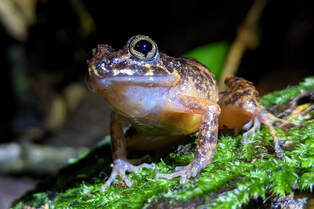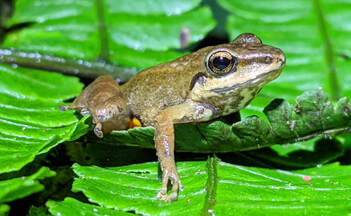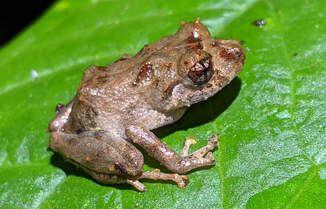



This month we have started work on our NSF-funded project in the eastern slopes of the Andes near Manu National Park. We have been working at this location for 25 years, and witnessed the dramatic collapse of montane frog communities in the early 2000s, along with the spread of the lethal frog chytrid fungus (Batrachochytrium dendrobatidis). While many stream-breeding frogs disappeared during the first epizootics in 2002-2006, most terrestrial-breeding species such as Oreobates granulosus in the inset photograph are still relatively abundant, despite many species being highly susceptible to chytridiomycosis. One possible explanation for their persistence is that these frogs have limited contact with water, and thus are less exposed to infection by the fungus' aquatic zoospores. The current project aims to explain how epizootics occur among terrestrial-breeding frogs, and how climate interacts with disease dynamics to trigger these epizootics.

During this first field trip, we established 12 transects (see photo below for a forest immersion at one of our transects), each 100 m long, in different forest habitats including riparian forest, disturbed areas (old landslides/stream beds), slope and ridge forests. We are capturing, marking and releasing all frogs (except for very small juveniles) found along these transects during three consecutive nights. We gently swab the skin of each frog to determine whether they are infected. So far the species with the highest recapture rate is Pristimantis toftae (pic right): one individual was even captured all three nights, and perched on the same fern!
The surveys planned over the next two years will allow us to collect natural history information on species that are rarely studied in detail. Data on movements, infection history, changes in spatial distribution and abundance will inform models on disease dynamics, with the hope of increasing our understanding of how a water-dependent fungus can spread among terrestrial organisms.
Unfortunately, our findings also confirmed that most stream-breeding frogs continue to be missing from these forests. However, a few species have started to recover, such as the toad Rhinella leptoscelis. We found this toad in three of our transects. Another interesting find was Pristimantis antisuyu (pic left), a species described only in 2018, which belongs to a group of Pristimantis frogs with cruciform eyes.

Unfortunately, our findings also confirmed that most stream-breeding frogs continue to be missing from these forests. However, a few species have started to recover, such as the toad Rhinella leptoscelis. We found this toad in three of our transects. Another interesting find was Pristimantis antisuyu (pic left), a species described only in 2018, which belongs to a group of Pristimantis frogs with cruciform eyes.
3D view of one of the transects in the montane forests near Manu National Park, Peru. Below, field team during the first trip in Many 2021.
0 Comments
Leave a Reply. |
Archives
June 2024
CATENAZZI LABNews from the lab Categories |